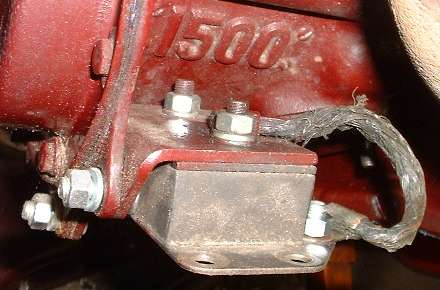The MGA With An Attitude
The Dire Consequences of a Missing or Disconnected ground strap. Preview the prior page first to understand where the engine ground strap is located and how it should be connected. This page is a review of many odd things that can happen if the ground strap is missing or disconnected or has a "dirty" bad contact.
Heater valve, and choke cables may be grounded to the dash panel. Throttle cable may be grounded through the throttle pedal linkages. If one of these cables has a good ground connection back to the chassis, it can turn red hot, possibly melt rubber grommets or rubber securing straps or burn the wiring harness were it might touch. The clutch slave cylinder hydraulic hose (if braid covered) may be grounded to the chassis bracket, or otherwise may be passing high current through the clutch fluid pipe to the master cylinder. That pipe may be a better conductor than the hose braid, so the braid could get hot enough to burn the rubber hydraulic hose. One possible ground path that may look robust but usually isn't would be the propshaft from gearbox to rear axle. The rear axle is usually electrically isolated with rubber pads on the leaf springs, and rubber hose for the brake line connection (unless it is a braid covered hose). That leaves a possible (but very shaky) path through the parking brake cable, back to the hand lever and tunnel onto the chassis frame, and those things are not designed to carry electrical current either. As bad as all that sounds, maybe you just stop trying to crank the engine if it doesn't go, and get lucky and not melt or burn anything. For a quick diagnostic you can grab a test light, ground it on the body or chassis, touch it anywhere on the engine, and see if it lights up when you try to crank the engine. A volt meter can serve the same purpose. There should be no light and no voltage. If you get light or any voltage on the engine block or rear plate or starter motor housing, you are missing the engine ground connection. As a side point, the test light can also be used to diagnose any electrical disconnect (when power is on). You can connect the test light tail alligator clip to a wire end terminal, and touch the test light probe end to the mating connection terminal or screw or body panel or chassis frame. The two mating connection points should always have the same voltage (or lack of voltage), so if it lights up it means you have a lost connection at the mating joint. |
